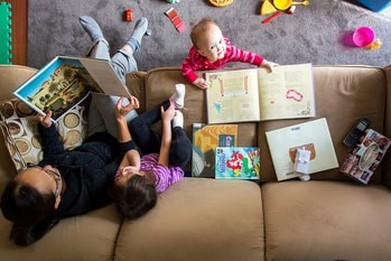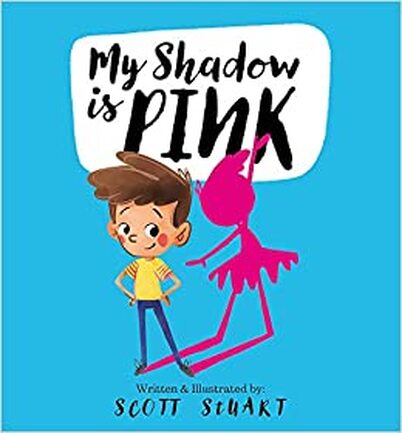A Book Review of My Shadow Is Pink
My Shadow Is Pink is appropriate for young children ages 3 - 8. It is written in rhyme with bright, fun illustrations that visually represent the concepts clearly. The main character is a young boy who does not fit in with the masculine norm of the men in his family who have blue shadows. His shadow is pink. "My shadow loves ponies and books and pink toys, princesses, fairies and things not for boys." The one thing his shadow likes most is wearing dresses and dancing around. Spinning, sparkling and twirling. Certainly not what society or his family expects of a boy. The author/illustrator, Scott Stewart, explores the emotional journey of a boy experiencing gender dysphoria. He highlights the struggles of feeling different and not fitting in with others in your gender. The story illustrates the father's emotional journey alongside his son. The distress of the boy and the parent working through this process are clearly displayed. As the boy experiences sadness and confusion, the shadow is depicted almost as a separate entity. The pink shadow is totally happy being pink and free to love what he loves. If only we could feel that free in expressing our authentic selves! Throughout the story, the boy notices the reactions of his father when he does what his shadow loves most. The looks of disapproval and concern have a strong impact on the boy's acceptance of himself. The father reassures the boy (and himself) that it is just a phase and he will grow out of it. When the time comes to start school, a whole new level of concern arises. He will be showing his authentic self to others outside of his home. This is scary for the boy and the Dad as they do not know how others will react to him. The students are instructed to dress up in their favorite thing for the first day. When the boy arrives in the classroom in a dress, his feeling of being different and not fitting in are staring him in the face, along with all of the kids. His intense feelings are then on display as he runs out of the classroom to his house and rips off the dress. He makes the realization that if his shadow was blue, he'd be making friends and being included like the others. After witnessing his son's emotional response and the persistence of his gender expression, the dad realizes the importance of supporting him. He tells his son that his shadow is who he is deep down and that he should embrace it. They walk back to school together with the boy having the knowledge that his dad has his back. After feeling the acceptance from his father, the boy was better able to accept himself. This left him more open to be accepted by his peers and provided him more strength to cope with the negative reactions. The book makes clear that the journey of the parent, and eventual acceptance, makes all the difference for the boy. Decisions around gender questioning and dysmorphia at a young age are challenging for parents. Should they let their little boy wear a dress or nail polish in public, knowing they will be ridiculed and bullied? As difficult as it can be, it is crucial to accept the child's identity and listen to their feelings. Research shows that 50% of children who question their gender identity at a young age go on to become transgender and 50% don't. The more persistent, insistent and consistent the child is over time with their gender expression, the more likely it will be true for them in the long term. At this young age, there is no need to do anything permanent such as legal name changes, but acceptance is key. Acceptance is: -Using their child's preferred pronouns or name -Allowing them to dress and have their hair as they prefer -Allowing them to follow their interests in toys and activities -Buying and reading age-appropriate books on this topic Doing the above, WILL NOT make a child transgender or gay if they are not. However, following their lead and accepting them WILL help them become more comfortable with themselves and others. It WILL give them the courage to go out in the world as their authentic selves and withstand the social disapproval they may endure. Children need a sense of safety and home may be the only place they feel that unconditional support. Children with gender dysphoria who have acceptance and support at home, fare much better with their mental health than children who do not have that family support. The biggest harm is done when a child feels shame around his authentic gender expression. When children feel shame, they question their own gut feelings. They attempt to cover up who they are to suit others. This can lead to self-loathing, depression and suicidal behaviors. Accepting a child's gender expression if it does not match the gender they were assigned at birth, is no easy task for most parents. The parent must address their own feelings regarding this issue in order to provide unconditional acceptance to their child. Many parents grieve the loss of the child they thought they had. This is a process and involvement in a support group for other parents of other gender-questioning children can be helpful. I strongly recommend this book for all children, whether they see themselves in it or gain insight into others. As a society, instead of bullying and ridiculing these children, we need to work toward understanding their predicament and acknowledging their courage. This book is a step in the right direction. If you wish to purchase this book, click HERE or find it at an independent bookstore near you. An Activity Idea for My Shadow Is Pink Materials Needed: -Sidewalk chalk in a variety of colors OR -Large paper, markers or crayons Directions:
1. Take the child outside on a sunny day and have them stand where they cast a shadow on cement or black top; Have the child make any body posture they want; Trace the shadow with sidewalk chalk. It can be fun to have the child trace your shadow also and for you to do the activity along with them OR On a large piece of paper, have the child draw an outline of him/herself as their shadow might look. 2. Discuss what the boy in the story's shadow liked the most. (Ie. ponies, princesses, fairies, dresses, twirling, etc.) 5. Have the child draw inside their shadow, what THEIR shadow likes the most. (Ie. favorite toys, colors, activities, clothing, movies, characters, etc.) 6. Have the child circle the things that other kids might think are more for a boy in blue; and more for a girl in pink. 7. Discuss the following with the child; Is it okay to have things in your shadow that others think are more for the opposite gender? 8. Should kids be teased because they have more pink or blue things in their shadows? Explain that everyone is different and that's what makes the world interesting. 9. Should kids hide what they really like just because other people don't agree it's for a boy or girl? If you had to hide important things about yourself that you really like ie. super heroes or watching Frozen, how might that make you feel? 10. Should everyone be able to show on the outside what they really like on the inside? Why or Why not? 11. Discuss that the book and the activity used the colors pink and blue as a way to demonstrate social views regarding boys and girls. However, can we all like whatever color we want? Can a girl like blue and a boy like pink? We like what we like and it's ok! And, last but not least, a little comic relief posted by the Parening Forward Facebook page!
1 Comment
|
Follow me on Twitter, Pinterest and LinkedIn
Categories
All
|

 RSS Feed
RSS Feed

